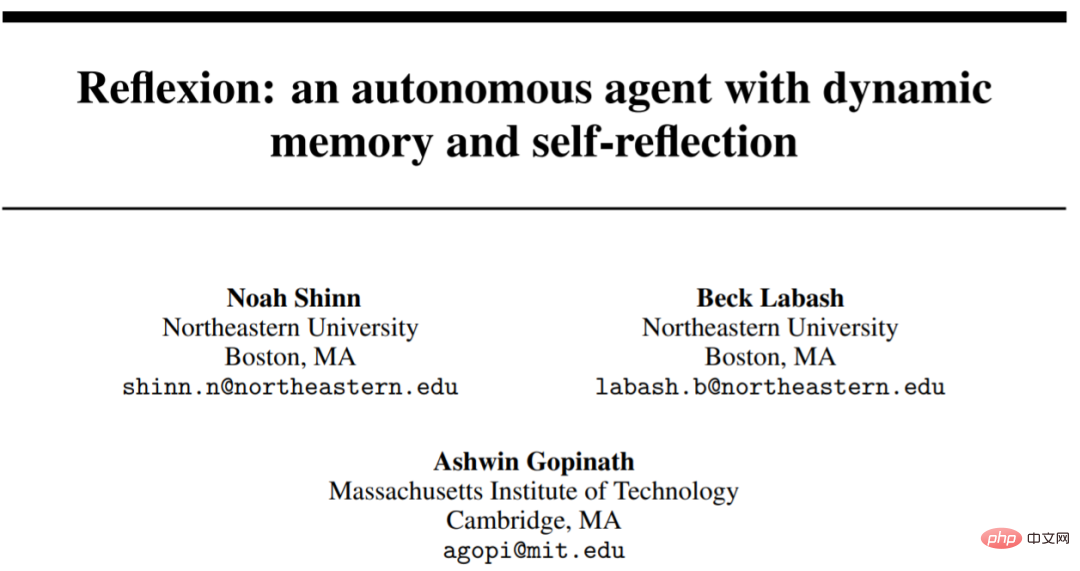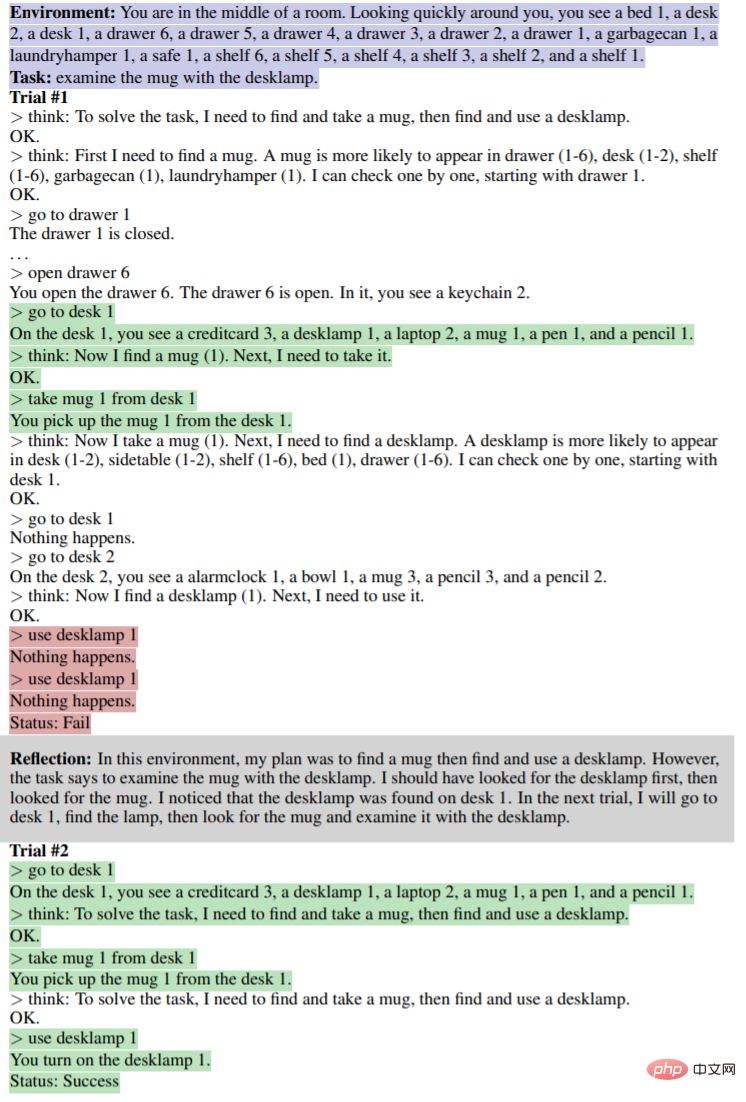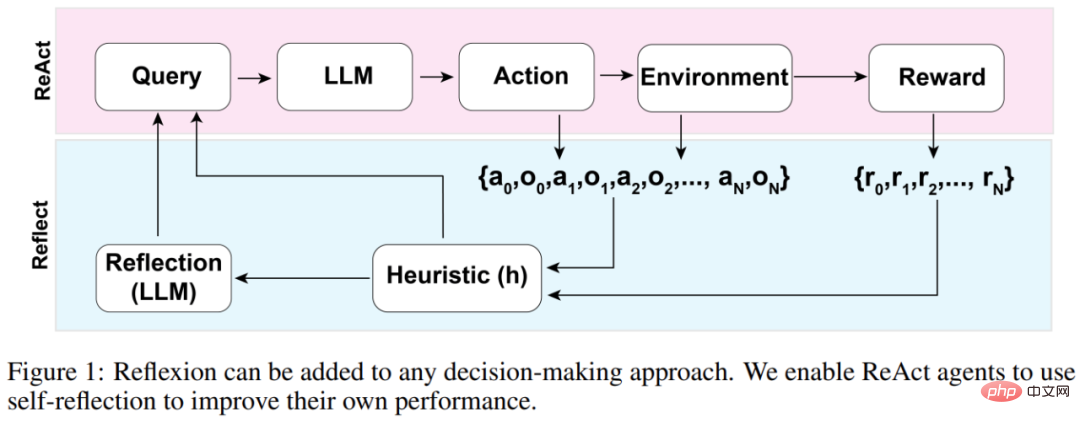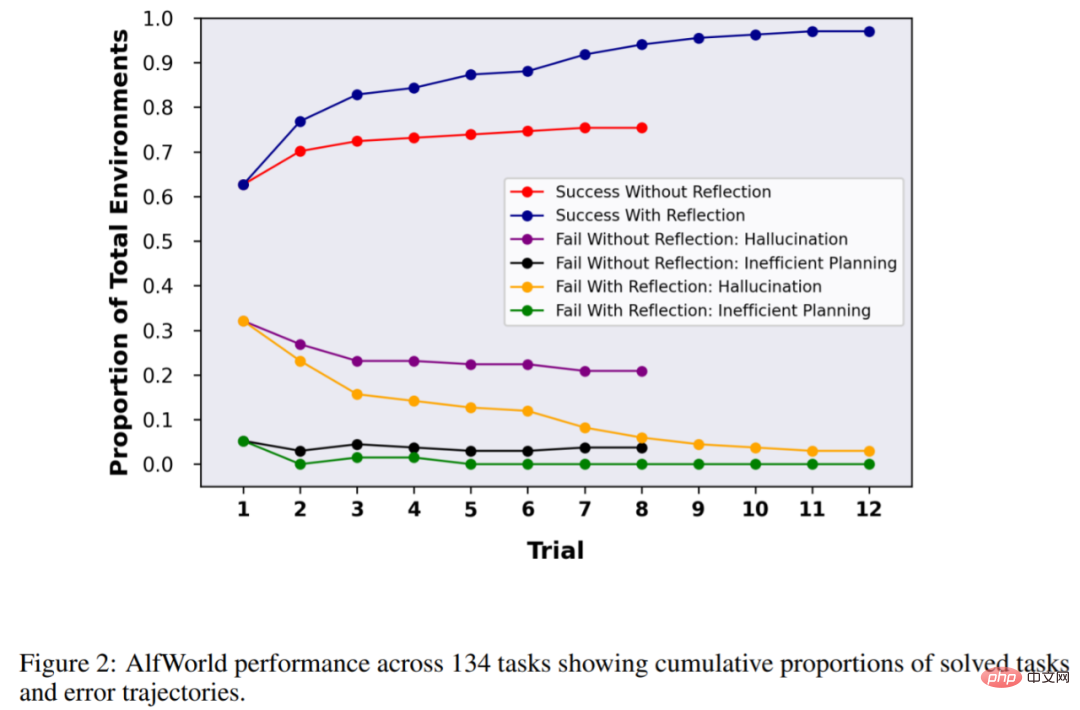 Technology peripherals
Technology peripherals
 AI
AI
 When GPT-4 reflected on its mistake: performance increased by nearly 30%, and programming ability increased by 21%
When GPT-4 reflected on its mistake: performance increased by nearly 30%, and programming ability increased by 21%
When GPT-4 reflected on its mistake: performance increased by nearly 30%, and programming ability increased by 21%
GPT-4’s way of thinking is becoming more and more human-like.
When humans make mistakes, they will reflect on their behavior to avoid making mistakes again. If large language models such as GPT-4 also have the ability to reflect, the performance will be improved by how much.
It is well known that large language models (LLMs) have demonstrated unprecedented performance on a variety of tasks. However, these SOTA methods usually require model fine-tuning, policy optimization and other operations on the defined state space. Due to the lack of high-quality training data and well-defined state space, it is still difficult to implement an optimized model. Furthermore, models do not yet possess certain qualities inherent to the human decision-making process, particularly the ability to learn from mistakes.
But now, in a recent paper, researchers from Northeastern University, MIT and other institutions proposed Reflexion, which gives the agent the ability to dynamically remember and self-reflect.
In order to verify the effectiveness of the method, this study evaluated the agent's ability to complete decision-making tasks in the AlfWorld environment, and to complete knowledge-intensive, search-based question and answer tasks in the HotPotQA environment. The mission success rates were 97% and 51% respectively.

Paper address: https://arxiv.org/pdf/2303.11366.pdf
Project address: https://github.com/GammaTauAI/ reflexion-human-eval
As shown in the figure below, in the AlfWorld environment, various items are placed in the room, and the agent is required to give a reasoning plan to get a certain object. The upper part of the figure below is due to The agent failed due to inefficient planning. After reflection, the agent realizes the error, corrects the reasoning trajectory, and gives a concise trajectory method (lower part of the figure).

Model Rethinking Flawed Search Strategies:

This paper shows that you can do this by requiring GPT-4 Reflect on "Why were you wrong?" and generate a new prompt for yourself, taking the reason for the error into account until the result is correct, thereby improving the performance of GPT-4 by an astonishing 30%.

Netizens can’t help but sigh: The development speed of artificial intelligence has exceeded our ability to adapt.

Method Introduction
The overall architecture of the Reflexion agent is shown in Figure 1 below, where Reflexion utilizes ReAct (Yao et al., 2023). In the first trial, the agent is given a task from the environment that constitutes the initial query, and then the agent performs a sequence of actions generated by the LLM and receives observations and rewards from the environment. For environments that offer descriptive or continuous rewards, the study limits the output to simple binary success states to ensure applicability.

After each action a_t, the agent will calculate a heuristic function h, as shown in the figure below

This heuristic function is designed to detect information illusion (i.e. false or wrong information) or inefficiency of the agent, and "tell" the agent when it needs to reflect (reflexion), where t is the time step, s_t is the current state, Ω represents the number of repeated action cycles, ε represents the maximum total number of executed actions, [a_o, o_0 . . . , a_(t−1), o_(t−1)] represents the trajectory history. repeat is a simple function that determines the number of times a loop of repeated actions produces the same result.
If function h tells the agent that reflection is needed, the agent queries the LLM to reflect its current task, trajectory history, and last reward, and then the agent resets the environment and tries again on subsequent trials. If function h does not tell the agent that reflection is needed, then the agent adds a_t and o_t to its trajectory history and queries the LLM for the next action.
If heuristic h recommends reflection at time step t, the agent will reflect based on its current state s_t, last reward r_t, previous actions and observations [a_0, o_0, . . . , a_t, o_t], and the agent's existing work storage mem, start a reflection process.
The purpose of reflection is to help the agent correct "illusions" and inefficiencies through repeated trials. The model used for reflection is an LLM that uses specific failure trajectories and ideal reflection examples to prompt.

The agent will iteratively carry out the above reflection process. In the experiments, the study set the number of reflections stored in the agent's memory to a maximum of 3 times in order to avoid queries exceeding the limits of the LLM. The run will terminate in the following situations:
- The maximum number of trials is exceeded;
- Failure to improve performance between two consecutive trials;
- Complete the task.
Experiments and results
AlfWorld provides six different tasks and more than 3,000 environments. These tasks require the agent to understand the target task, formulate a sequential plan for subtasks, and perform Perform operations in a given environment.
The study tested the agent in 134 AlfWorld environments, with tasks including finding hidden objects (for example, finding a fruit knife in a drawer), moving objects (for example, moving a knife to a cutting board), and using other object to manipulate another object (for example, refrigerating tomatoes in a refrigerator).
Without reflection, the accuracy of the agent was 63%, and Reflexion was added for comparison. The results showed that the agent was able to handle 97% of the environment in 12 trials and failed to solve only 4 out of 134 tasks.

The next experiment was conducted in HotPotQA, which is a data set based on Wikipedia and contains 113k question and answer pairs. It is mainly used to challenge the agent to parse content. and the ability to reason.
On HotpotQA's 100 question-answer pair tests, the study compared the base agent and the Reflexion-based agent until they failed to improve accuracy over successive trials. The results show that the performance of the basic agent has not improved. In the first trial, the accuracy of the basic agent was 34% and the accuracy of the Reflexion agent was 32%. However, after 7 trials, the performance of the Reflexion agent improved significantly. The improvement is close to 30%, which is much better than the basic agent.

Similarly, when testing the model's ability to write code, GPT-4 with Reflexion is also significantly better than regular GPT-4:

The above is the detailed content of When GPT-4 reflected on its mistake: performance increased by nearly 30%, and programming ability increased by 21%. For more information, please follow other related articles on the PHP Chinese website!

Hot AI Tools

Undresser.AI Undress
AI-powered app for creating realistic nude photos

AI Clothes Remover
Online AI tool for removing clothes from photos.

Undress AI Tool
Undress images for free

Clothoff.io
AI clothes remover

AI Hentai Generator
Generate AI Hentai for free.

Hot Article

Hot Tools

Notepad++7.3.1
Easy-to-use and free code editor

SublimeText3 Chinese version
Chinese version, very easy to use

Zend Studio 13.0.1
Powerful PHP integrated development environment

Dreamweaver CS6
Visual web development tools

SublimeText3 Mac version
God-level code editing software (SublimeText3)

Hot Topics
 1379
1379
 52
52
 Debian mail server firewall configuration tips
Apr 13, 2025 am 11:42 AM
Debian mail server firewall configuration tips
Apr 13, 2025 am 11:42 AM
Configuring a Debian mail server's firewall is an important step in ensuring server security. The following are several commonly used firewall configuration methods, including the use of iptables and firewalld. Use iptables to configure firewall to install iptables (if not already installed): sudoapt-getupdatesudoapt-getinstalliptablesView current iptables rules: sudoiptables-L configuration
 How debian readdir integrates with other tools
Apr 13, 2025 am 09:42 AM
How debian readdir integrates with other tools
Apr 13, 2025 am 09:42 AM
The readdir function in the Debian system is a system call used to read directory contents and is often used in C programming. This article will explain how to integrate readdir with other tools to enhance its functionality. Method 1: Combining C language program and pipeline First, write a C program to call the readdir function and output the result: #include#include#include#includeintmain(intargc,char*argv[]){DIR*dir;structdirent*entry;if(argc!=2){
 How to set the Debian Apache log level
Apr 13, 2025 am 08:33 AM
How to set the Debian Apache log level
Apr 13, 2025 am 08:33 AM
This article describes how to adjust the logging level of the ApacheWeb server in the Debian system. By modifying the configuration file, you can control the verbose level of log information recorded by Apache. Method 1: Modify the main configuration file to locate the configuration file: The configuration file of Apache2.x is usually located in the /etc/apache2/ directory. The file name may be apache2.conf or httpd.conf, depending on your installation method. Edit configuration file: Open configuration file with root permissions using a text editor (such as nano): sudonano/etc/apache2/apache2.conf
 How to optimize the performance of debian readdir
Apr 13, 2025 am 08:48 AM
How to optimize the performance of debian readdir
Apr 13, 2025 am 08:48 AM
In Debian systems, readdir system calls are used to read directory contents. If its performance is not good, try the following optimization strategy: Simplify the number of directory files: Split large directories into multiple small directories as much as possible, reducing the number of items processed per readdir call. Enable directory content caching: build a cache mechanism, update the cache regularly or when directory content changes, and reduce frequent calls to readdir. Memory caches (such as Memcached or Redis) or local caches (such as files or databases) can be considered. Adopt efficient data structure: If you implement directory traversal by yourself, select more efficient data structures (such as hash tables instead of linear search) to store and access directory information
 Debian mail server SSL certificate installation method
Apr 13, 2025 am 11:39 AM
Debian mail server SSL certificate installation method
Apr 13, 2025 am 11:39 AM
The steps to install an SSL certificate on the Debian mail server are as follows: 1. Install the OpenSSL toolkit First, make sure that the OpenSSL toolkit is already installed on your system. If not installed, you can use the following command to install: sudoapt-getupdatesudoapt-getinstallopenssl2. Generate private key and certificate request Next, use OpenSSL to generate a 2048-bit RSA private key and a certificate request (CSR): openss
 How to implement file sorting by debian readdir
Apr 13, 2025 am 09:06 AM
How to implement file sorting by debian readdir
Apr 13, 2025 am 09:06 AM
In Debian systems, the readdir function is used to read directory contents, but the order in which it returns is not predefined. To sort files in a directory, you need to read all files first, and then sort them using the qsort function. The following code demonstrates how to sort directory files using readdir and qsort in Debian system: #include#include#include#include#include//Custom comparison function, used for qsortintcompare(constvoid*a,constvoid*b){returnstrcmp(*(
 How to perform digital signature verification with Debian OpenSSL
Apr 13, 2025 am 11:09 AM
How to perform digital signature verification with Debian OpenSSL
Apr 13, 2025 am 11:09 AM
Using OpenSSL for digital signature verification on Debian systems, you can follow these steps: Preparation to install OpenSSL: Make sure your Debian system has OpenSSL installed. If not installed, you can use the following command to install it: sudoaptupdatesudoaptininstallopenssl to obtain the public key: digital signature verification requires the signer's public key. Typically, the public key will be provided in the form of a file, such as public_key.pe
 How Debian OpenSSL prevents man-in-the-middle attacks
Apr 13, 2025 am 10:30 AM
How Debian OpenSSL prevents man-in-the-middle attacks
Apr 13, 2025 am 10:30 AM
In Debian systems, OpenSSL is an important library for encryption, decryption and certificate management. To prevent a man-in-the-middle attack (MITM), the following measures can be taken: Use HTTPS: Ensure that all network requests use the HTTPS protocol instead of HTTP. HTTPS uses TLS (Transport Layer Security Protocol) to encrypt communication data to ensure that the data is not stolen or tampered during transmission. Verify server certificate: Manually verify the server certificate on the client to ensure it is trustworthy. The server can be manually verified through the delegate method of URLSession



